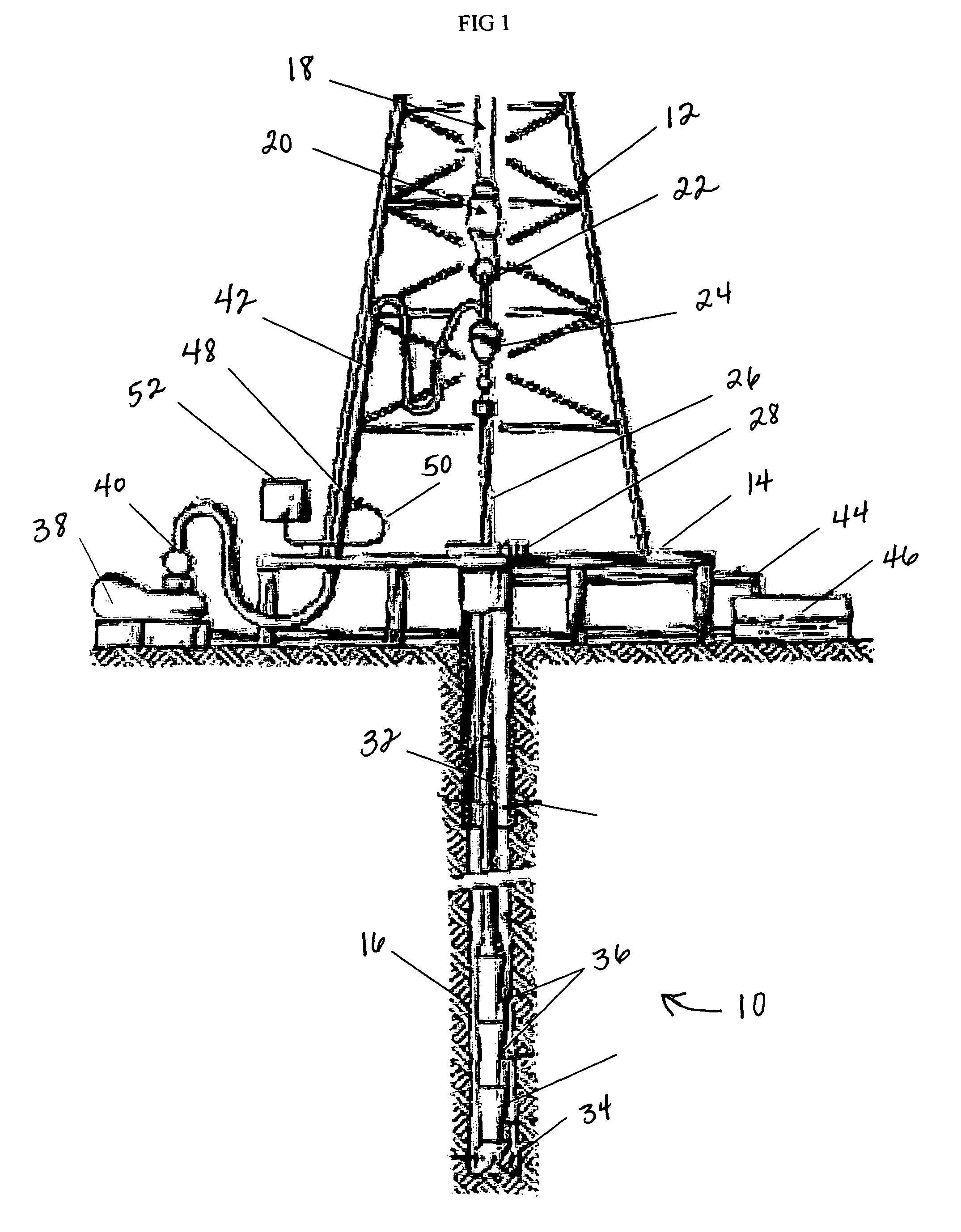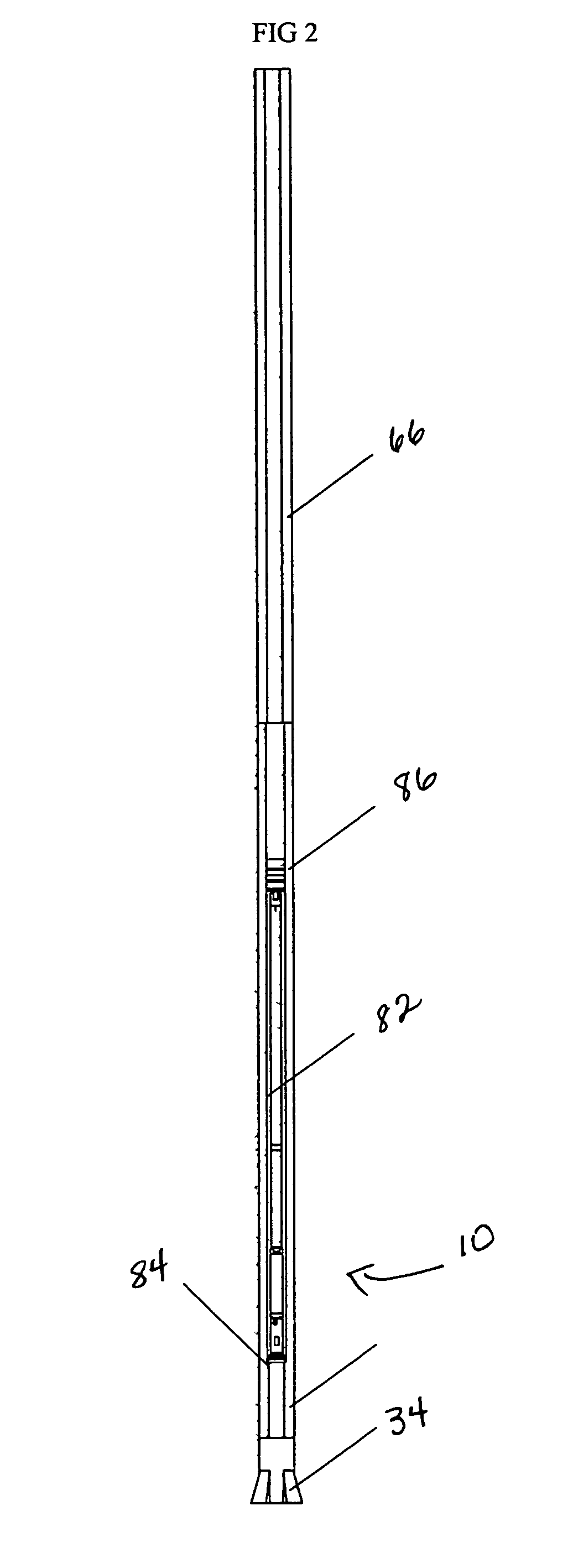This method has many clear and apparent disadvantages, such as the need to stop drilling for an extended period of time, the need to stop
fluid circulation and bear the risk of having the
drill string stuck in the hole or have the bore well collapse around the
drill string.
In addition, the need to make several successive closely spaced measurements cannot be met without spending an inordinate amount of time surveying and very little time actually spent drilling the bore well.
Although this method allows for the ability to make successive and rapid measurement of the parameters of interest, it too has several disadvantages in that the cable also requires a swivel joint at the surface with the capability to feed electrical signals through it while maintaining a tight seal and contain high pressures all while being rotated.
In addition, this method has the added
disadvantage in that as extra lengths of
drill string are added to drill deeper, the cable and attached probe will have to be removed from the
drill string completely, the new length of
drill string attached, and the cable and probe re-inserted into the bore well.
Many more example of devices similar to these listed previously can be found in the literature, however further listing of these devices will be stopped as their practical
usability in the drilling environment has been severely limited due to certain mitigating factors.
In the case of devices that propose the usage of electrical or magnetic signals in the earth, the significant attenuation caused by the earth and certain types of formations limit the depth to which these devices can be successfully deployed.
The ability to effectively deliver sufficient electromagnetic energy into the formation is limited by the available power sources and as such, the attenuation of the signals cannot be overcome with any degree of effectiveness.
Devices that impart vibrations onto the drill string and earth are limited by the attenuation of the
signal due to the threaded connections between lengths of drill string and due to the inherent attenuation of the
signal as it travels long distances along the drill string.
In addition, these methods have proven unreliable to be used while drilling as the action of the drilling bit
cutting the earth imparts vibrations onto the drill string, which overwhelm the
signal being sent.
These types of apparatus have been predominantly limited to surveying only when drilling is suspended.
The devices listed above do have certain limitations in that they are non-reciprocating in nature.
Another known problem with this type of prior art is that configuration of the blades allows constant
exposure to fluid flow and results in faster
erosion due to the linear arrangement of the valve to fluid flow.
But the basic limitation is the need to lower and retrieve them from the bottom of the well through the
drill pipe using the slick line.
A real limitation of these tools is that
wireline comes in lengths thousands of feet long, typically mounted on a big
truck, while
drill pipe is generally 30 ft long.
This is often very cumbersome and has other drawbacks that have been previously discussed.
The prior art did not, however, lead to viable products at industry wants.
It is essentially impossible to drill a straight or vertical well bore.
It is understood that the environment of drilling leads to an unfriendly environment for downhole tools.
Further, accuracy issues arise in these conditions such as
directional drilling usually requires relatively precise sensor data to accurately steer the well.
The sum of the previous typically means expensive operations.
Traditional MWD tools are expensive to build and expensive to operate.
And most in the consuming industry who drill straight holes could not afford them in the early days.
In addition, these tools were finicky and required constant monitoring and maintenance.
All this leads to a situation where MWD are generally hard to build and operate in the first place and they are relegated to the higher end of the industry.
The industry still needs to survey and today their options are generally slicklines that are
time consuming and risky such as but not limited to the fact
pipe tends to get stuck if operators do not circulate the fluid;
wireline which are often impractical and almost as expensive as MWD; and full MWD which is expensive.
However, there are several limitations both in the capability and in the
usability of the available products as has been generally discussed above.
In addition, the constant flow of
drilling fluid through or past the MWD tool causes significant
erosion of exposed components and can cause significant damage to tools if improperly designed or operated.
These additives often tend to be
abrasive in nature and further exasperate the
erosion problems associated with the flow of the fluid past the tool.
These filler materials tend to be granular in nature and clog or cover inlet and outlet ports, screens and other associated hydraulic components that are part of most MWD tools.
Further, the extreme temperatures and pressures that are present in the bottom of the bore well often necessitate the use of expensive and exotic sealing mechanisms and materials, which increase the costs of operating the MWD tools, and thereby reduce their
usability to the wider
market place.
Still furthermore, due to the high costs associated with drilling oil and gas bore holes, any time that is spent repairing, maintaining or servicing failed or
non functional equipment results in a severe reduction in the productivity of the whole drilling operation.
All these and other factors not listed combine to make the design, manufacture and use of MWD tool an expensive prospect for the industry and therefore result in high costs for the customer, the driller.
These high costs tend to make MWD tools unavailable or unaffordable to the majority of the drilling market.
Although MWD tools that are capable of providing sufficient information to the driller in a reasonably effective manner have been limited to the higher end drilling operations, usually those involving drilling in high cost environments (such as
offshore drilling platforms) or in specific limited markets (such as directionally drilling well bores), a large portion of the drilling market is predominantly involved in the drilling of straight vertical well bores at relatively low costs and as such, do not have access to a simple, reliable MWD tool that can provide them with the minimum of information that they may require to effectively drill these bore holes.
 Login to View More
Login to View More  Login to View More
Login to View More 


